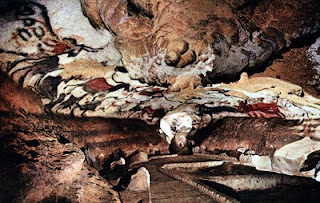F
or most of our history our race wasn’t human. Before civilization, before
self-awareness, we were just another beast on the African savannah, hunting our
prey and trying to survive. We didn’t ask questions or seek their answers; we
didn’t have power, or luxuries, or comprehension. Somewhere along the way we
gained those properties. We looked up at the stars and wondered. We held a dead
antelope and felt a mixture of appreciation and regret. We worshiped something
greater than ourselves. We grew, not just in numbers, but inside. At some point
in our history we became human, and art was invented.
Because of better preservation and our prolific intellect, we have lots of artistic property from the dawn of civilization (3,000 BCE) and on. But
these new, “civilized” animals are too like us; their problems are our
problems, and their worries our worries. By studying them we learn too much
about ourselves. It’s the art from pre-agricultural societies that can give us
profound insight on the fundamentals of our psychology, philosophy, and
religion. These “humans,” existing in the shadowy realm between man and beast,
are the link to our more feral past. The problem is that Neolithic art is
scarce, and often simple. That’s why the cave paintings at Lascaux are so
precious.

You’re
going to kill me, aren’t you? Why? Are we not brothers? No, I suppose were not.
You’ve become…different. You’re no longer like us. You’ve changed. You love me,
but you need to kill me to survive. How must that feel—to kill that which you
love. To kill your brothers. To be self-aware. To be different. To be alone in
a world of life.
How heavily this must have
weighed on our early minds. Which brings me to another work; perhaps the
strangest of all Lascaux art: “Shaft of the Dead Man.”
W
hat's going on here? A seeming human, but with a bird’s head?
Being run over by a bison? Is that a crane below them? Or a bird staff? Is that
a rhino running away from the scene?
My interpretation of the scene concerns wish
fulfillment. The character is drawn as part bird to reconcile the growing
separation between the human and animal world. That, or the bird head is a mask the
character dons to interact/communicate with other beasts. So either the culture
sees itself as part animal, or wants to be, and this manifests in the
bird-human hybrid depicted here.
And then there’s the difference in size. The height of the
bird-character reflects the ambition of human dominance in the natural order; the
bison is, after all, charging down and killing him. This is a violent scene,
with the destruction of human life and perhaps the disembowelment of the bison,
while the rhino flees in terror. The artist(s) must recognize that humans are
climbing ever higher on the food chain, and are achieving mastery over the other
animals. But this control is not complete, and the bison challenges and even
succeeds in resisting human power.
But maybe not. Maybe the human is simply trying to be an equal to
the bison and rhino, greeting them as fellow animals, and is rejected. The
former attacks him, while the latter runs. Do we see the enactment of exile
from the natural order? The Lascaux paintings are dated around 17,000-13,000
BCE, which is relatively late in our development. Is this the last attempt at
reintegration with the animal kingdom? Is our failure here a catalyst for
civilization?
Some claim the odd bird totem below is evidence of shamanism.
Whether or not they’re in a “dreamlike trance” is debatable; the proximity of
the bison indicates a physical, not mental interaction. But the
meta-context of the scene—on a wall in the dark recesses of a cave
structure—argues for evocation. What in the world were these painters doing
down here? Why go through all the trouble and danger of creating these
galleries? What need did it serve? If we posit these animals are to be taken as
mere replications of reality, we ignore the role of art in our own world.
Surely we have to see at least some of the paintings as symbolic. Symbolic of
what thought? Fertility rituals? Early Gods? The “other?”
Looking at the galleries together, there is movement here, and
narrative. Perhaps the world depicted is overwhelming the growing consciousness
of man. Perhaps the shaman is trying to cope with this expanding reality and
finds himself outmatched. (Note there is a scarcity of homo sapiens represented in these paintings.) For the first time man is viewing his world
through an artistic lens. He is part of a bigger picture, and struggles to find
his place in it.
Ultimately I see a practical motivation for these works, as well as an abstract one. Ostensibly the caves were used for religious/shamanistic rituals, probably animal/human fertility. This would justify the time and resources poured into the endeavor, as the participants would have expected concrete returns on such an investment. Beyond this reasoning, however, I would bet that early man found this kind of artistic work therapeutic and fulfilling. Soon people found painting/crafting useful for working through inner emotions that have no other outlet (in addition to telling stories). Thus Lascaux represents the torrent of human consciousness arising from our burgeoning psychology.
As for “The Shaft of the Dead Man”, this work is one such instance of that consciousness. The strangeness of the scene is oozing with profound texture; I don't know why the artist created it, but I can feel its echoes across time. Drawing yourself as a dead entity is a level of self-awareness that no other organism has yet matched. The harmony of the galleries, the life and vibrancy it depicts, is at odds with the awkward and assaulted bird man above. In this mural of life, we don't belong.






